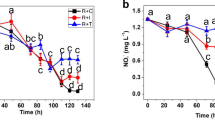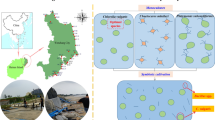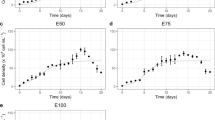Abstract
The bioremediation capacity of the red macroalga Palmaria palmata was assessed by two experiments. First, uptake rates of P. palmata cultured in four treatments with varying levels and ratios of the N sources ammonium (NH4 +) and nitrate (NO3 −) (18/15, 0/30, 30/45, 50/65 μM) were measured over a 3-h period to evaluate N source preference. Secondly, P. palmata were cultured in five treatments with varying levels and ratios of ammonium and nitrate (300/12, 0/312, 500/12, 0/512, 250/262 μM) for 3 weeks to evaluate specific growth rates, protein content, and ammonia toxicity. Palmaria palmata had a higher affinity for NH4 + than for NO3 − as N source. However, in the single N source trials, NO3 − uptake was higher than that of NH4 +. The maximum specific growth rate of 11.99 % day−1 was observed in the 0/512 μM ammonium/nitrate treatment after 3 weeks, whereas the minimum specific growth rate of 2.21 % day−1 was observed in the 500/12 μM ammonium/nitrate treatment after 3 weeks. NO3 − supported higher growth rates, whereas NH4 + increased tissue N, and therefore protein content. Total protein content of the algal tissue was significantly higher in P. palmata of the NH4 + treatments, reaching up to 20.6 % DW, than of those from the NO3 -treatments. Palmaria palmata showed signs of poisoning after 3 weeks in the highest NH4 + treatment. This study indicates that P. palmata is a suitable species for ecological engineering in integrated multitrophic aquaculture systems as it shows a relatively high growth performance, high nutrient uptake rates, and elevated protein content under NH4 + supply.



Similar content being viewed by others
References
Abreu MH, Pereira R, Yarish C, Buschmann AH, Sousa-Pinto I (2013) IMTA with Gracilaria vermiculophylla: productivity and nutrient removal performance of the seaweed in a land-based pilot scale system. Aquaculture 312:77–87
Atkinson MJ, Smith SV (1983) C:N:P ratios of benthic marine plants. Limnol Oceanogr 28:568–574
Buck BH, Bucholz CM (2005) Response of offshore cultivated Laminaria saccharina to hydrodynamic forcing in the North Sea. Aquaculture 250:674–691
Cahill PL, Hurd CL, Lokman M (2010) Keeping the water clean—seaweed biofiltration outperforms traditional bacterial biofilms in recirculating aquaculture. Aquaculture 306:153–159
Chopin T (2014) Seaweeds: top mariculture crop, ecosystem service provider. Global Aquaculture Advocate 17:54–56
Corey P, Kim JK, Duston J, Garbary DJ, Prithiviraj B (2013) Bioremediation potential of Palmaria palmata and Chondrus crispus (Basin Head): effect of nitrate and ammonium ratio as nitrogen source on nutrient removal. J Appl Phycol 25:1349–1358
D’Elia CF, DeBoer JA (1978) Nutritional studies of two red algae. II. Kinetics of ammonium and nitrate uptake. J Phycol 14:266–272
Demetropoulos CL, Langdon CJ (2004) Enhanced production of Pacific dulse (Palmaria mollis) for co-culture with abalone in a land-based system: nitrogen, phosphorus, and trace metal nutrition. Aquaculture 235:433–455
Dosdat A, Servais F, Métailler R, Huelvan C, Desbruyères E (1996) Comparison of nitrogenous losses in five teleost fish species. Aquaculture 141:107–127
FAO (2014) The state of world fisheries and aquaculture 2014. Food and Agriculture Organization of the United Nations. Fisheries and Aquaculture Dept, Rome
Fredriksen S, Rueness J (1989) Culture Studies of Gelidium latifolium (Grev.) Born et Thur. (Rhodophyta) from Norway. Growth and nitrogen storage in response to varying photon flux density, temperature and nitrogen availability. Bot Mar 32:539–546
Galland-Irmouli AV, Fleurence J, Lamghari R, Lucon M, Rouxel C, Barbaroux O, Bronowicki J-P, Villaume C, Guéant J-L (1999) Nutritional value of proteins from edible seaweed Palmaria palmata (Dulse). J Nutr Biochem 10:353–359
Goddard S (1996) Feed management in intensive aquaculture. Chapman & Hall, New York, p 194pp
Hagopian DS, Riley JG (1998) A closer look at the bacteriology of nitrification. Aquacult Eng 18:223–244
Haines KC, Wheeler PA (1978) Ammonium and nitrate uptake by the marine macrophytes Hypnea musciformis (Rhodophyta) and Macrocystis pyrifera (Phaeophyta). J Phycol 14:319–324
Handy RD, Poxton MG (1993) Nitrogen pollution in mariculture: toxicity and excretion of nitrogenous compounds by marine fish. Rev Fish Biol Fisher 3:205–241
Hanisak MD (1979) Nitrogen limitation of Codium fragile spp. tomentosoldes as determined by tissue analysis. Mar Biol 50:333–337
Hanisak MD, Harlin MM (1978) Uptake of inorganic nitrogen by Codium fragile subsp. tomentosoides (Chlorophyta). J Phycol 14:450–454
Hernández I, Martínez-Aragón JF, Tovar A, Pérez-Lloréns JL, Vergara JJ (2002) Biofiltering efficiency in removal of dissolved nutrients by three species of estuarine macroalgae cultivated with sea bass (Dicentrarchus labrax) waste waters 2. Ammonium. J Appl Phycol 14:375–384
Howell BR, Baynes SM (2004) Abiotic factor. In: Moksness E, Kjørsvik E, Olsen Y (eds) Culture of cold-water marine fish., pp 7–27
Kang JH, Kim S, Joon-Baek L, Chung IK, Park SR (2014) Nitrogen biofiltration capacities and photosynthetic activity of Pyropia yezoensis Ueda (Bangiales, Rhodophyta): groundwork to validate its potential in integrated multi-trophic aquaculture (IMTA). J Appl Phycol 26:947–955
Kim JK, Kraemer GP, Neefus CD, Chung IK, Yarish C (2007) Effects of temperature and ammonium on growth, pigment production and nitrogen uptake by four species of Porphyra (Bangiales, Rhodophyta) native to the New England coast. J Appl Phycol 19:431–440
Kim JK, Duston J, Corey P, Garary DJ (2013) Marine finfish effluent bioremediation: Effects on stocking density and temperature on nitrogen removal capacity of Chondrus crispus and Palmaria palmata (Rhodophyta). Aquaculture 414–415:210–216
Le Gall L, Pien S, Rusig AM (2004) Cultivation of Palmaria palmata (Palmariales, Rhodophyta) from isolated spores in semi- controlled conditions. Aquaculture 229:181–191
Lourenço SO, Barbarino E, De-Paula JC, Da S, Pereira LO, Lanfer Marquez UM (2002) Amino acid composition, protein content and calculation of nitrogen-to-protein conversion factors for 19 tropical seaweeds. Phycol Res 50:233–241
Martinez B, Rico JM (2004) Inorganic nitrogen and phosphorous uptake kinetics in Palmaria palmata and Chondrus crispus (Rhodophyta). J Phycol 40:642–650
Martinez-Aragon JF, Hernandez I, Perez-Llorens JL, Vazquez R, Vergara JJ (2002) Biofiltering efficiency in removal of dissolved nutrients by three species of estuarine macroalgae cultivated with sea bass (Dicenntrarchus labrax) waste waters: 1. Phosphate. J Appl Phycol 14:365–374
Morgan KC, Simpson FJ (1981) Cultivation of Palmaria (Rhodymenia) palmata: effect of high concentrations of nitrate and ammonium on growth and nitrogen uptake. Aquat Bot 11:167–171
Morgan KC, Shacklock PF, Simpson FJ (1980) Some aspects of the culture of Palmaria palmata in greenhouse conditions. Bot Mar 23:765–770
Msuya FE, Neori A (2008) Effect of water aeration and nutrient load level on biomass yield, N uptake and protein content of the seaweed Ulva lactuca cultured in seawater tanks. J Appl Phycol 20:1021–1031
Nelson GS, Glenn EP, Conn J, Moore D, Walsh T, Akutagawa M (2001) Cultivation of Gracilaria parvispora (Rhodophyta) in shrimp-farm effluent ditches and floating cages in Hawaii: a two-phase polyculture system. Aquaculture 192:239–248
Neori A, Nobre AM (2012) Relationship between trophic level and economics in aquaculture. Aquac Econ Manage 16:40–67
Neori A, Cohen I, Gordin H (1991) Ulva lactuca biofilters for marine fishpond effluents. II. Growth rate, yield and C:N ratio. Bot Mar 34:483–489
Neori A, Krom MD, Ellner SP, Boyd CE, Popper D, Rabinovitch R, Davison PJ, Dvir O, Zuber D, Ucko M, Angel D, Gordin H (1996) Seaweed biofilters as regulators of water quality in integrated fish-seaweed culture units. Aquaculture 141:183–199
Neori A, Shpigel M, Ben-Ezra D (2000) A sustainable integrated system for culture of fish, seaweed and abalone. Aquaculture 186:279–291
Neori A, Chopin T, Troell M, Buschmann AH, Kraemer GP, Halling C, Shpigel M, Yarish C (2004) Integrated aquaculture: rationale, evolution and state of the art emphasizing seaweed biofiltration in modern mariculture. Aquaculture 231:361–391
Niell FX (1976) C:N ratio in some marine macrophytes and its possible ecological significance. Bot Mar 19:347–350
Pang S, Lüning K (2004) Tank cultivation of the red alga Palmaria palmata: effects of intermittent light on growth rate, yield and growth kinetics. J Appl Phycol 16:93–99
Pang S, Lüning K (2006) Tank cultivation of the red alga Palmaria palmata: year-round induction of tetrasporangia, tetraspore release in darkness and mass cultivation of vegetative thalli. Aquaculture 252:20–30
Person-Le Ruyet J, Chartois H, Quéméner L (1995) Comparative acute ammonia toxicity in marine fish and plasma ammonia response. Aquaculture 136:1–194
Provasoli L (1968) Media and prospects for the cultivation of marine algae. In: Watanabe A, Hattori A (eds) Cultures and Collections of Algae. Proc. U.S.–Japan Conf.. Hakone. Sept. 1966. Jpn. Soc. Plant Phycol., pp 63–75
Sagert S, Schubert H (2000) Acclimation of Palmaria palmata (Rhodophyta) to light intensity: comparison between artificial and natural light field. J Phycol 36:1119–1128
Sánchez de Pedro R, Niell FX, Carmona R (2013) Differential nutrient uptake by two segregated red algae in an estuarine intertidal zone. Phycologia 52:461–471
Schuenhoff A, Shpigel M, Lupatsch I, Ashkenazi A, Msuya FE, Neori A (2003) A semirecirculating, integrated system for the culture of fish and seaweed. Aquaculture 221:167–181
Sutherland JE, Lindstrom SC, Nelson WA, Brodie J, Lynch MDJ, Hwang MS, Choi H-G, Miyata M, Kikuchi N, Oliveira MC, Farr T, Neefus C, Mols-Mortensen A, Milstein D, Müller KM (2011) A new look at an ancient order: generic revision of the Bangiales (Rhodophyta). J Phycol 47:1131–1151
Syrett PJ (1962) Nitrogen assimilation. In: Lewin RA (ed) Physiology and biochemistry of algae. Academic Press, New York, pp 171–188
Thomas TE, Harrison PJ (1985) Effects of nitrogen supply on nitrogen uptake, accumulation and assimilation in Porphyra perforata (Rhodophyta). Mar Biol 85:269–278
Thomas TE, Harrison PJ (1987) Rapid ammonium uptake and nitrogen interactions in five intertidal seaweeds grown under field conditions. J Exp Mar Biol Ecol 107:1–8
Troell M, Halling C, Neori A, Chopin T, Buschmann AH, Kautsky N, Yarish C (2003) Integrated mariculture: asking the right questions. Aquaculture 226:69–90
Acknowledgments
The German Federal Office for Agriculture and Food (Bundesanstalt für Landwirtschaft und Ernährung, BLE) funded this study, which is a part of the project Offshore Site Selection (OSS) (313-06.01-28-1-73.010-10). Many thanks go to Sabine Strieben, Alfred Wegener Institute, Helmholtz Centre for Polar and Marine Research (AWI), for her dedicated help and to Prof. Dr. C. Wiencke and the working group “Seaweed Biology,” AWI, for scientific and logistic assistance, especially Claudia Daniel and Andreas Wagner for technical support. I like to thank the two reviewers for improving the manuscript by critical comments and suggestions.
Author information
Authors and Affiliations
Corresponding author
Rights and permissions
About this article
Cite this article
Grote, B. Bioremediation of aquaculture wastewater: evaluating the prospects of the red alga Palmaria palmata (Rhodophyta) for nitrogen uptake. J Appl Phycol 28, 3075–3082 (2016). https://doi.org/10.1007/s10811-016-0848-x
Received:
Revised:
Accepted:
Published:
Issue Date:
DOI: https://doi.org/10.1007/s10811-016-0848-x




